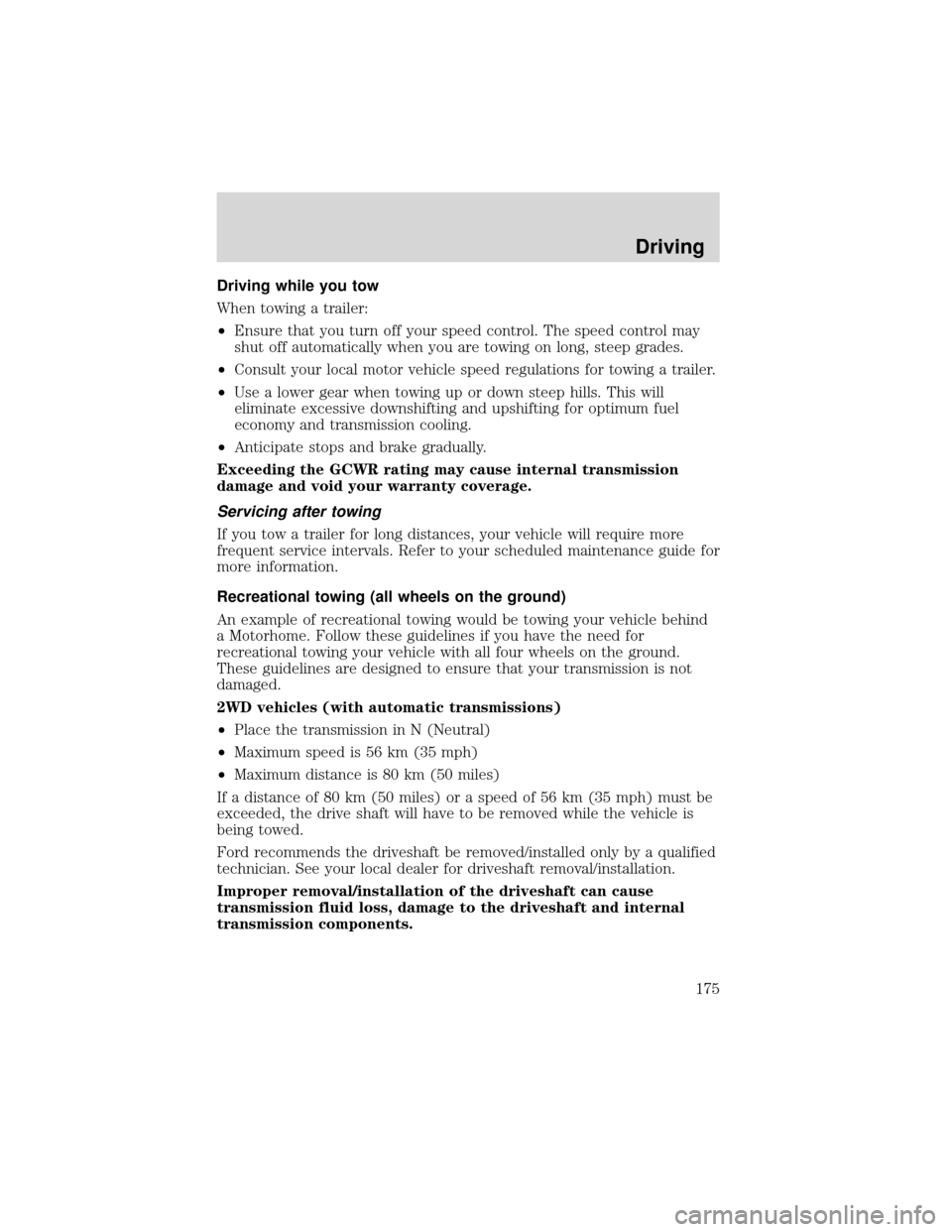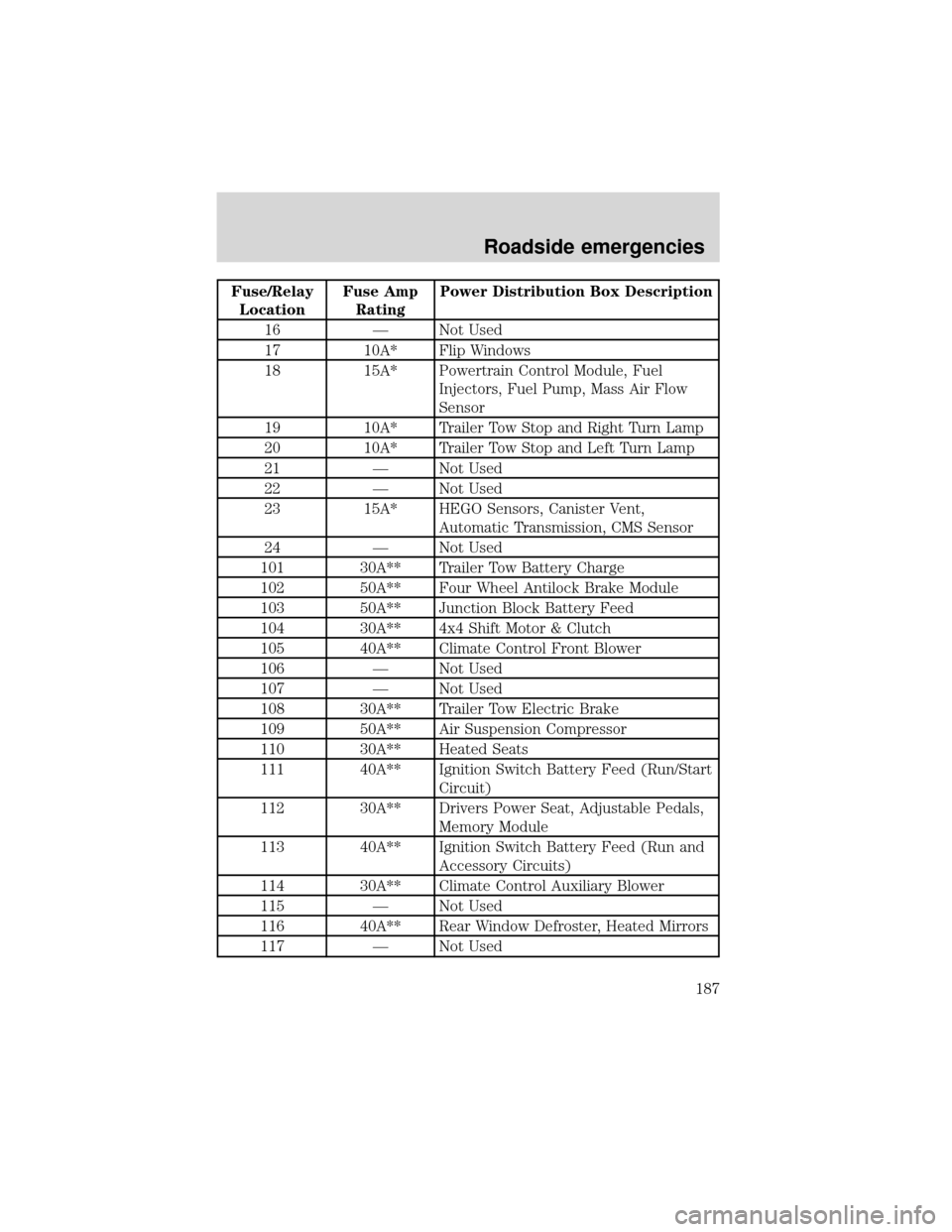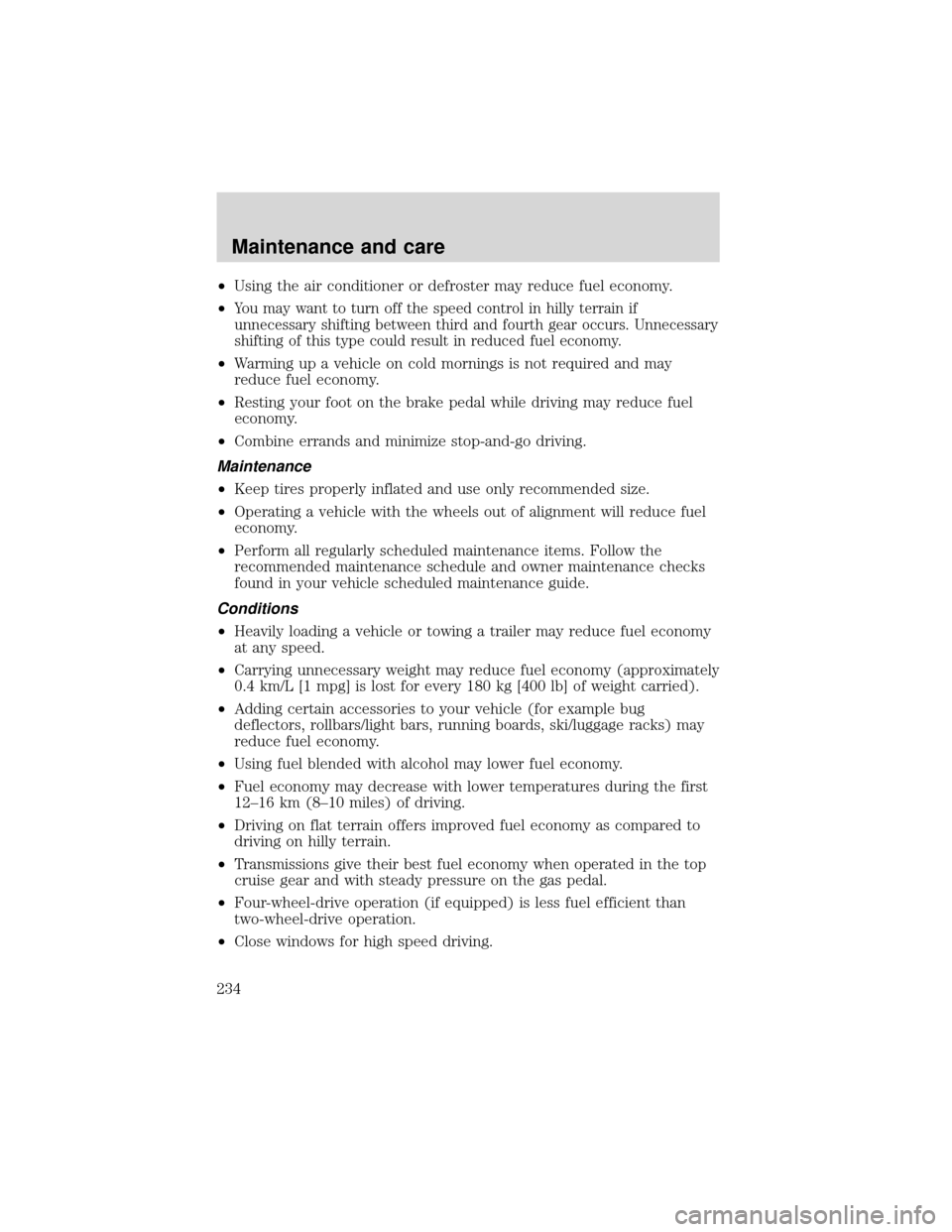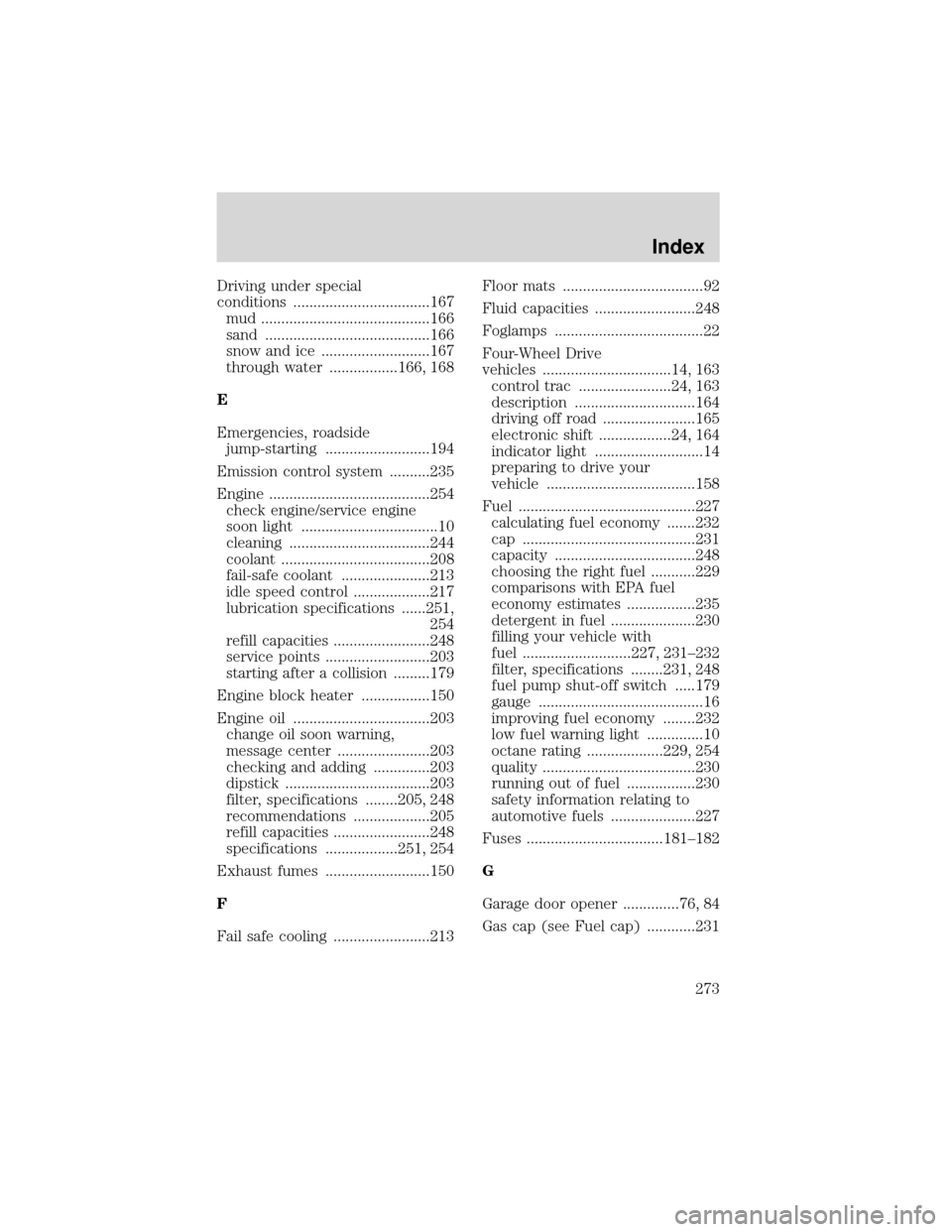Page 175 of 280

Driving while you tow
When towing a trailer:
•Ensure that you turn off your speed control. The speed control may
shut off automatically when you are towing on long, steep grades.
•Consult your local motor vehicle speed regulations for towing a trailer.
•Use a lower gear when towing up or down steep hills. This will
eliminate excessive downshifting and upshifting for optimum fuel
economy and transmission cooling.
•Anticipate stops and brake gradually.
Exceeding the GCWR rating may cause internal transmission
damage and void your warranty coverage.
Servicing after towing
If you tow a trailer for long distances, your vehicle will require more
frequent service intervals. Refer to your scheduled maintenance guide for
more information.
Recreational towing (all wheels on the ground)
An example of recreational towing would be towing your vehicle behind
a Motorhome. Follow these guidelines if you have the need for
recreational towing your vehicle with all four wheels on the ground.
These guidelines are designed to ensure that your transmission is not
damaged.
2WD vehicles (with automatic transmissions)
•Place the transmission in N (Neutral)
•Maximum speed is 56 km (35 mph)
•Maximum distance is 80 km (50 miles)
If a distance of 80 km (50 miles) or a speed of 56 km (35 mph) must be
exceeded, the drive shaft will have to be removed while the vehicle is
being towed.
Ford recommends the driveshaft be removed/installed only by a qualified
technician. See your local dealer for driveshaft removal/installation.
Improper removal/installation of the driveshaft can cause
transmission fluid loss, damage to the driveshaft and internal
transmission components.
Driving
175
Page 187 of 280

Fuse/Relay
LocationFuse Amp
RatingPower Distribution Box Description
16—Not Used
17 10A* Flip Windows
18 15A* Powertrain Control Module, Fuel
Injectors, Fuel Pump, Mass Air Flow
Sensor
19 10A* Trailer Tow Stop and Right Turn Lamp
20 10A* Trailer Tow Stop and Left Turn Lamp
21—Not Used
22—Not Used
23 15A* HEGO Sensors, Canister Vent,
Automatic Transmission, CMS Sensor
24—Not Used
101 30A** Trailer Tow Battery Charge
102 50A** Four Wheel Antilock Brake Module
103 50A** Junction Block Battery Feed
104 30A** 4x4 Shift Motor & Clutch
105 40A** Climate Control Front Blower
106—Not Used
107—Not Used
108 30A** Trailer Tow Electric Brake
109 50A** Air Suspension Compressor
110 30A** Heated Seats
111 40A** Ignition Switch Battery Feed (Run/Start
Circuit)
112 30A** Drivers Power Seat, Adjustable Pedals,
Memory Module
113 40A** Ignition Switch Battery Feed (Run and
Accessory Circuits)
114 30A** Climate Control Auxiliary Blower
115—Not Used
116 40A** Rear Window Defroster, Heated Mirrors
117—Not Used
Roadside emergencies
187
Page 234 of 280

•Using the air conditioner or defroster may reduce fuel economy.
•
You may want to turn off the speed control in hilly terrain if
unnecessary shifting between third and fourth gear occurs. Unnecessary
shifting of this type could result in reduced fuel economy.
•Warming up a vehicle on cold mornings is not required and may
reduce fuel economy.
•Resting your foot on the brake pedal while driving may reduce fuel
economy.
•Combine errands and minimize stop-and-go driving.
Maintenance
•Keep tires properly inflated and use only recommended size.
•Operating a vehicle with the wheels out of alignment will reduce fuel
economy.
•Perform all regularly scheduled maintenance items. Follow the
recommended maintenance schedule and owner maintenance checks
found in your vehicle scheduled maintenance guide.
Conditions
•Heavily loading a vehicle or towing a trailer may reduce fuel economy
at any speed.
•Carrying unnecessary weight may reduce fuel economy (approximately
0.4 km/L [1 mpg] is lost for every 180 kg [400 lb] of weight carried).
•Adding certain accessories to your vehicle (for example bug
deflectors, rollbars/light bars, running boards, ski/luggage racks) may
reduce fuel economy.
•Using fuel blended with alcohol may lower fuel economy.
•Fuel economy may decrease with lower temperatures during the first
12–16 km (8–10 miles) of driving.
•Driving on flat terrain offers improved fuel economy as compared to
driving on hilly terrain.
•Transmissions give their best fuel economy when operated in the top
cruise gear and with steady pressure on the gas pedal.
•Four-wheel-drive operation (if equipped) is less fuel efficient than
two-wheel-drive operation.
•Close windows for high speed driving.
Maintenance and care
234
Page 273 of 280

Driving under special
conditions ..................................167
mud ..........................................166
sand .........................................166
snow and ice ...........................167
through water .................166, 168
E
Emergencies, roadside
jump-starting ..........................194
Emission control system ..........235
Engine ........................................254
check engine/service engine
soon light ..................................10
cleaning ...................................244
coolant .....................................208
fail-safe coolant ......................213
idle speed control ...................217
lubrication specifications ......251,
254
refill capacities ........................248
service points ..........................203
starting after a collision .........179
Engine block heater .................150
Engine oil ..................................203
change oil soon warning,
message center .......................203
checking and adding ..............203
dipstick ....................................203
filter, specifications ........205, 248
recommendations ...................205
refill capacities ........................248
specifications ..................251, 254
Exhaust fumes ..........................150
F
Fail safe cooling ........................213Floor mats ...................................92
Fluid capacities .........................248
Foglamps .....................................22
Four-Wheel Drive
vehicles ................................14, 163
control trac .......................24, 163
description ..............................164
driving off road .......................165
electronic shift ..................24, 164
indicator light ...........................14
preparing to drive your
vehicle .....................................158
Fuel ............................................227
calculating fuel economy .......232
cap ...........................................231
capacity ...................................248
choosing the right fuel ...........229
comparisons with EPA fuel
economy estimates .................235
detergent in fuel .....................230
filling your vehicle with
fuel ...........................227, 231–232
filter, specifications ........231, 248
fuel pump shut-off switch .....179
gauge .........................................16
improving fuel economy ........232
low fuel warning light ..............10
octane rating ...................229, 254
quality ......................................230
running out of fuel .................230
safety information relating to
automotive fuels .....................227
Fuses ..................................181–182
G
Garage door opener ..............76, 84
Gas cap (see Fuel cap) ............231
Index
273